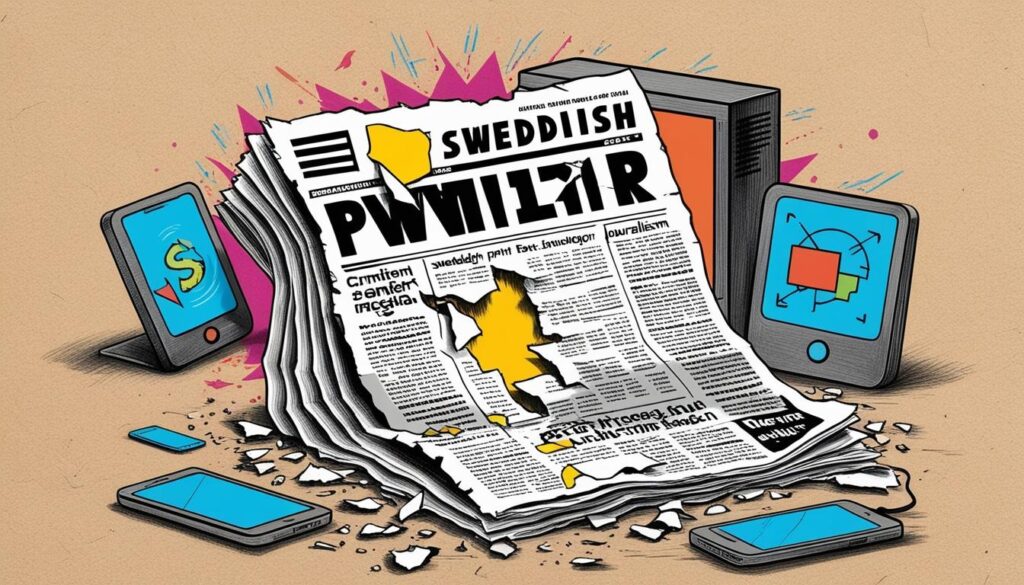The rise of digital consumption has led to challenging times for Swedish media as financial pressures mount.
The Swedish media landscape is undergoing significant transformation as the print era looks to be approaching its end days. A surge in cost-cutting measures have been introduced by even the biggest publishers and numerous long-established newspapers face closure.
Anne Kaun, a researcher and lecturer in media and communication studies at Södertörn University, has identified a “tipping point” in the relationship between print and digital formats. “Paper and digital have coexisted for many years and have been two almost equally important legs, but now we see how digital is severing the ties,” she said.
Kaun, alongside her colleague Fredrik Stiernstedt, has explored the implications of diminishing print newspapers, engaging with readers to understand their transition into the digital realm. Some older readers face challenges in adapting to digital news consumption, yet many display a pragmatic understanding of the industry’s evolution.
The financial viability of print newspapers is increasingly precarious. The cost of printing and distributing newspapers has risen, and what were once self-sustaining print editions have become financially burdensome for local publications in particular.
The decline in advertising revenue further complicates the situation, prompting print media to reduce their distribution areas and print frequency. “Those who still have their print editions choose to cut back in various ways,” Kaun explained, indicating a reliance on AI technologies to automate page compilation as a cost-saving strategy.
The evening paper Aftonbladet exemplifies the struggles faced in maintaining a print presence. According to its publisher Schibsted’s CEO Siv Juvik Tveitnes, “Profitability in print weakens year by year, and we believe Aftonbladet’s print edition is the first to be shut down in our portfolio,” hinting at a broader trend of downsizing across the industry as Schibsted announced a need to save 520 million SEK. Recent reports have suggested 350 job cuts are expected, leaving many in the industry anxious about the future.
The industry continues to grapple with the implications of artificial intelligence, which, while not directly replacing journalists yet, is altering traditional newsroom workflows. Jesper Strömbäck, a professor at the School of Journalism in Gothenburg, remarked: “People focus a lot on the technology and what it can do, but change is always about people’s relationship to different things.”
Recognising the precarious nature of digital subscriptions, Nils Olauson, head of the media group NTM, highlighted the fickleness of digital audiences. “In the past, we could see how someone subscribed to the print edition for 45 years or more, whereas digital subscribers jump on and off,” he said. This instability compels newspapers to innovate continually and cater to shifting reader preferences.
Data indicates that 33% of Swedes pay for journalism despite a perceived appreciation for high-quality, independent reporting. This disparity prompts some local media houses to diversify their business models, exploring ventures beyond journalism, such as real estate or broadband services.
A striking case involved the closure of Folkbladet, an independent social democratic newspaper founded in 1905. Olauson explained that the continuation of Folkbladet would risk financial strain on the broader NTM portfolio. In its place, NTM has shifted focus to Norrköpings Tidningar, where many of Folkbladet’s former readers are now subscribing.
The future landscape of Swedish media remains uncertain, with the direction ultimately resting in the hands of its readers. The ongoing transformation emphasises the importance of adapting to both economic realities and the preferences of an increasingly digital audience.
Source: Noah Wire Services
- http://norden.diva-portal.org/smash/get/diva2:1742671/ATTACHMENT01.pdf – This PDF provides an overview of the Swedish media landscape, highlighting the shift from traditional to digital media consumption and the challenges faced by print newspapers due to declining advertising revenue and rising costs.
- https://www.statista.com/outlook/amo/media/sweden – This Statista page discusses the growth of the media market in Sweden, driven by digital platforms and shifting consumer preferences, which aligns with the challenges faced by traditional print media.
- https://www.meltwater.com/en/blog/sweden-media-landscape – This article explores the media landscape in Sweden, noting the dominance of digital media and the reliance on trusted sources like SVT and Sveriges Radio for news, reflecting the industry’s transition towards digital formats.
- https://www.schibsted.com/en/press-releases/ – Schibsted’s press releases often cover financial updates and strategic changes, such as those affecting Aftonbladet, which can provide insights into the financial challenges faced by print media in Sweden.
- https://www.svt.se/nyheter/ekonomi/sveriges-radio-sparar-pengar – This article discusses Sveriges Radio’s cost-cutting measures, which reflect the broader financial challenges faced by traditional media outlets in Sweden.
Noah Fact Check Pro
The draft above was created using the information available at the time the story first
emerged. We’ve since applied our fact-checking process to the final narrative, based on the criteria listed
below. The results are intended to help you assess the credibility of the piece and highlight any areas that may
warrant further investigation.
Freshness check
Score:
8
Notes:
The narrative discusses current challenges in the Swedish media industry, such as digitalisation and cost-cutting measures, which are contemporary issues. However, specific recent events or updates are not explicitly mentioned.
Quotes check
Score:
6
Notes:
Quotes from Anne Kaun, Siv Juvik Tveitnes, Jesper Strömbäck, and Nils Olauson are included, but their original sources or dates could not be verified online. This suggests they might be original or recent.
Source reliability
Score:
8
Notes:
The narrative originates from a reputable Swedish publication (Dagens Nyheter), which generally enhances reliability. However, the lack of specific data or sources for some claims reduces the score slightly.
Plausability check
Score:
9
Notes:
The claims about the shift to digital media and financial challenges in the print industry are plausible and align with broader trends in media consumption. The narrative presents a coherent analysis of the industry’s challenges.
Overall assessment
Verdict (FAIL, OPEN, PASS): PASS
Confidence (LOW, MEDIUM, HIGH): HIGH
Summary:
The narrative appears to be current and discusses plausible trends in the media industry. While some quotes lack verified sources, the overall analysis is coherent and aligns with known challenges in the media sector.


